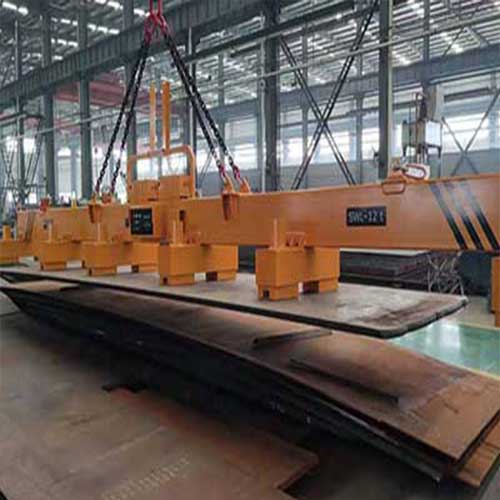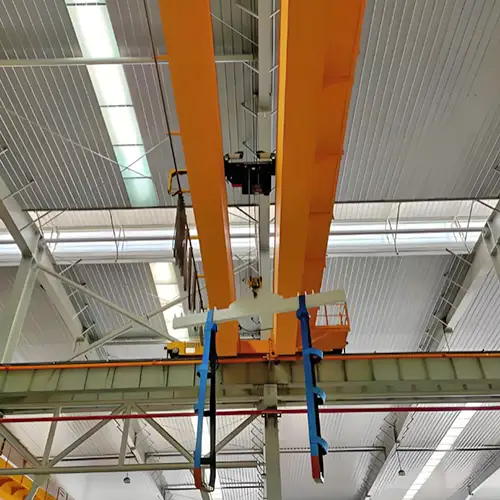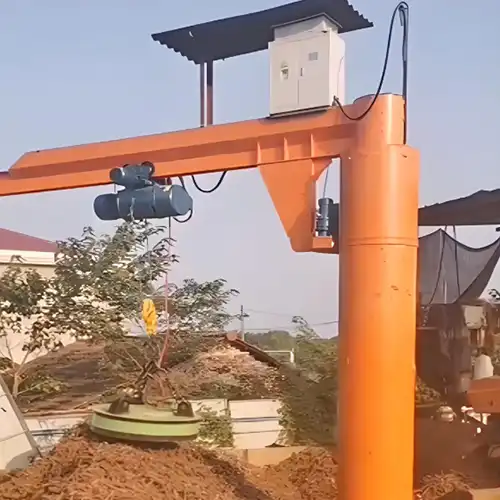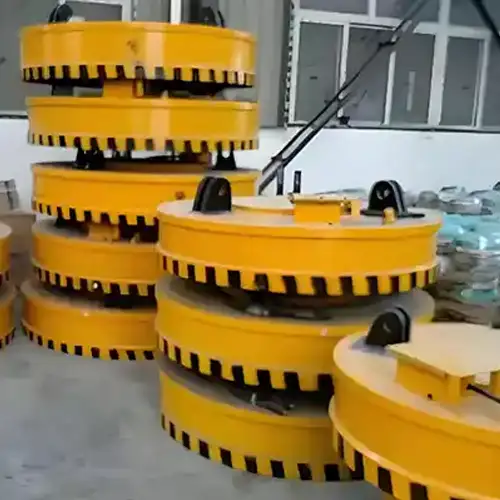Electro-Permanent Magnets for All Types of Overhead Lifting Equipment
Electro Permanent Magnets for all types of overhead lifting equipment, ie. overhead crane, gantry crane & other lifting equipment for steel metal objects.
Category: Magnetic Crane
Your Trusted Overhead Bridge Crane Manufacturer & Supplier
Electro-Permanent Magnets for All Types of Overhead Lifting Equiptment
Electro Permanent Magnets for all types of overhead lifting equipment, ie. overhead crane, gantry crane & other lifting equipment for steel metal objects.
Electro permanent lifting magnets are designed, manufactured, and used in a variety of industrial material handling applications.
The electro-permanent lifting magnet is made up of two magnetic power sources. One set of magnets has a high intrinsic coercive force (Hci), while the other has a low Hci. Electrical wire coils are wound around the low Hci magnets. The magnetic orientation of the coils can be changed by changing the direction of the current pulse in the coils. When the magnetic directions of the two sets of magnets are the same, the permanent-electro lifting magnet obtains attractive force to the ferromagnetic work piece. There would be no magnetic force to clamp if opposite magnetic directions absorb each other's energy.
We offer a variety of lifting magnets for handling ferrous materials such as steel plates, coils, strips, profiles, pipes, billets, round bars, rails, and so on.Lifting magnets can be customized based on the application.

Advantages
- Electro permanent magnets combine the efficiency of electro magnets with the safety of permanent magnets.
- The electro permanent magnetic system is inherently safe and is unaffected by a power outage.
- There is no need for a backup battery system.
- With no moving parts inside and no heat generation, the system is completely maintenance-free and durable.
- There is no compression or deformation of the load during the lifting/clamping/holding procedure.
Applications
Because electro permanent magnets are extremely powerful and adaptable, they can be employed as material handling/lifting magnets, work-piece holding magnetic chucks, magnetic clamping systems for molds and dies, and magnetic grippers for automation. For many years, we have provided custom built magnets for a variety of sectors such as metal fabrication, shipbuilding, steel mill, automobile, medical industry, mechanical engineering, transport company, material store, and so on.
The electro permanent magnets are widely used in:
- Electro Permanent Magnet is the most modern technology, with 95% energy savings and complete safety when compared to previous electromagnet methods.
- Electro permanent magnetic solutions, which are powered by magnetism, cover a wide range of industrial sectors, including magnetic lifting systems, magnetic clamping systems, magnetic workholding, and magnetic grasping.
- Electro permanent lifting magnets for ferrous loads are commonly utilized in steel manufacturing, port businesses offshore, steel transport, and other industries. Steel structure •Shipyard •Metal cutting workshops •Warehouses •Foundries •Coil and pipe distributors •Steel wholesalers •Engineering workshops, Steel construction, Steel wholesalers, Mechanical engineering, Shipyards and offshore, Train and rolling stock, Metal cutting workshops, Molds and dies, Automotive, White, Medical, Energy, Automation, etc.
Our engineering experience is focused on assisting customers in thriving in the manufacturing business by providing cost-effective magnetic solutions and services to meet their application needs.
What is electro permanent magnet?
Two different magnetic materials are present in an electro permanent magnet, which uses electricity to activate or deactivate its own magnetic field. It combines the advantages of an electromagnet with the characteristics of a permanent magnet.
An electro permanent magnet is an improved combination of an electro magnet , in which the external magnetic field can be activated or deactivated by an electric current pulse in a wire wound around a portion of the magnet but is not maintained by electricity. It is made up of coils, steel, magnet materials, and an electronic control system.
How does an electro permanent magnet work?
Two magnetic materials, one magnetically hard (such as Nd-Fe-B) and one semi-hard (such as Alnico), are combined to form an electro permanent magnet, which is then coiled in a coil and capped at both ends with a magnetically soft material. The materials are magnetized together by a pulse of current with one polarity, which raises the external magnetic flux flow. The semi-hard material's magnetization is reversed by an oppositely polarized current pulse, but the hard material's magnetization remains unaltered. This reduces the external magnetic flux by diverting some or all of the flux to circulate inside the device.
What are the features of electro permanent magnet?
- Double magnet systems are used in a special electro permanent magnet technology.
- Eelectro permanent magnet only requires electricity when turning the magnet ON and OFF.
- When compared to a traditional electromagnet, over 95% of electricity is saved.
- In the event of an unexpected power outage, magnetic force still exists.
- Low cost of maintenance
What's the difference of electromagnet and electro-permanent magnet?
The electrical on/off switches for both industrial magnets are present. Two points make up the bulk of the difference.
First, an electromagnet requires constant electric power for operation; if the power source is abruptly shut off, the magnet loses its magnetic force. The difference between electromagnets and electro-permanent magnets is that the former does not require electricity for its operation. If the power is turned off, the weight can still be held, lifted, grasped, or secured.
Second, the heat produced by the electromagnet's continuous power input could reduce the efficiency of its workholding during machining. As opposed to that, an electro-permanent magnet has no problems.
What happens when un-expected electrical power failure occurs?
When used in lifting or workholding applications, electro permanent magnets continue to exert their magnetic force even in the case of a power outage, so there is no need to worry about ferrous loads or objects dropping off.
Furthermore, until the electrical power is turned back on, the magnet cannot be turned off.
What Are The Advantages of Electro Permanent Magnetic Products?
Higher Safety: The magnetic force endures while working and is impervious to an abrupt power breakdown or blackout. No suspended load will ever drop, ensuring workplace safety.
Convenience: There is no need for a battery backup system.
Energy-saving: During the MAG and DEMAG processes, electricity is only used briefly. No electricity was used while working. When compared to a conventional electromagnet, the electrical consumption is 95% lower.
What affect the magnetic fore of electro-permanent magnet?
Internal factors
- The impact of RbFeB's coercivity on the adsorption force The coercivity of the RbFeB is closely related to the adsorption force of the electro-permanent magnets under certain circumstances. The adsorption force grows quickly as the coercivity does as well. The permanent magnet's magnetic field is only enhanced by the magnetic field created by the electric current; the main result is a shift in the magnetic field's direction. Therefore, within reasonable bounds, the higher the coercivity of a permanent magnet, the better. The highest coercivity permanent magnet material is RbFeB magnets, also referred to as the "king of permanent magnets."
- The effect of Alnico's coercivity on the adsorption force Regardless of how the Alnico coercivity varies after demagnetization, the magnetic force is roughly 20N. The electromagnetic clamping tools may also fail to release after a power outage when a closed magnetic circuit has developed, which could interfere with normal operation. Using DC pulses, the remaining magnetism can be removed. This implies that instead of the voltage being wiped out when the magnetic pole is de-energized, a reverse pulse is injected to remove any remaining magnetism. As long as there is no residual magnetism after the pole has been de-energized, the energy of the reverse pulse can be calculated based on the unique pole structure.
External factors
- The effect of the current value applied on the magnetic force is as follows: When the coil is not energized, RbFeB permanent magnets have a particular attraction to the mold; at this time, the magnetic induction line and magnetic induction intensity line of permanent magnets are not controlled by the current, is a natural state; when the coil is energized, the magnetic induction line and magnetic induction intensity line of permanent magnets are controlled by the current. Size and other conditions in electro-permanent magnets are inevitable; only change in the value of the loading current can be The magnetic force gradually increases as the current strength does as well.
- The magnetic force is affected by the thickness of the air layer: You can vary the thickness of the air layer in the electro-permanent magnetic pole size and other variables to obtain the relationship between the thickness of the air layer and the magnetic pole force. The space between the contact surface of the electro-permanent magnet and the mold determines the thickness of the air layer. The magnetic induction weakens as the magnetic field radiates away from the RbFeB permanent magnet. As the thickness of the air layer grows, the adsorption force of the electro-permanent magnet decreases fast. According to tests, when the air layer thickness is 2 mm, the adsorption force of the electro permenant magnetic chuck reduces to 40.9 N/ cm2, which is insufficient to meet the mold's clamping requirements.
Electro permanent magnetic lifter v.s. vacuum lifter
These days, more and more machinery manufacturers prefer electric permanent magnetic lifters to vacuum lifters to lift steel plates. Why a large number of manufacturers choose to use magnetic lifters? There's a brief guide for you to understand. Read on if you'd like to learn more.

Electro permanent magnetic lifter
The magnetic force produced by the electric permanent magnetic lifter is created by energizing the internal coil. It then passes through the magnetic conductive panel and firmly attracts the workpiece that is in contact with its surface. The magnetic force is then destroyed by disabling the internal coil, resulting in demagnetization and the removal of the workpiece.The electric permanent magnet lifter has a strong magnetic force, with a maximum suction force of 16kg/cm2, a uniform and adjustable magnetic force distribution, and it can be used for a variety of powerful machining, rough machining, and finishing. Additionally, in terms of machining accuracy, the strong and uniform disk suction force ensures the highest machining accuracy even if the workpiece extends beyond the table because continuous operation doesn't produce heat and the holding force of the electronically controlled strong suction cup doesn't need to be maintained by connecting the power supply.The electromagnetic lifter may automatically position an additional device. The workpiece can be clamped or released in 0.3 seconds by simply pressing a button, which can significantly increase production efficiency.

Vacuum lifter
The vacuum lifter connects to the vacuum equipment through the nozzle, touches the workpiece, and starts the vacuum equipment to suction. This produces a negative air pressure in the suction cup, which securely suctions and transports the workpiece. The task of workpiece transport is finished once the vacuum equipment reduces the air pressure in the vacuum lifter to zero pressure and separates it from the workpiece after the workpiece has been delivered to its destination. Therefore, in order to ensure that the surface of the steel plate is sufficiently flat when using the vacuum lifter to transport steel plates, the operator must clean out impurities such iron filings from the steel plate. We need to prevent the situation where the steel plates either fall off or cannot be hoisted.
Additionally, as the vacuum lifter comes into direct touch with the steel metals when carrying the loads, the vacuum lifter suffers from considerable wear. To prevent vacuum lifter failure and a reduction in the lifting capacity of steel and metal items, machinery producers must prepare the vacuum lifter's spare parts in advance.
Due to the aforementioned reasons, an increasing number of machinery manufacturers are switching from using vacuum lifters to electric permanent magnet lifters in order to lift long, large and heavy steel metal objects or loads. The magnetic force is powerful, the power won't lose its magnetism, and it is difficult to fail because the electric permanent magnet lifter combines the special benefits of both permanent magnet lifters and electromagnetic lifters. Additionally, the criteria for the steel plate are less strict. It's more reliable and practical.
When buying a special spreader for steel metal objects, whether it be a vacuum lifter or an electro-permanent magnetic lifter, machinery manufacturers need to choose a reasonable type based on the specifications of the steel loads in their own workshops and the on-site hoisting circumstances.
FAQ on Electroperment magnet
How Is The Quality Guarantee System of electroperment magnet ?
- Our engineering staff is supported by European professors.
- The ISO 9001:2015 standard is strictly followed in the establishment of our quality management system.
- Before delivery, every manufactured magnets must pass rigorous material and quality inspections.
Is it possible to adsorb the workpiece through the container, which has a thickness of roughly 3-5 mm?
Customized spreaders are typically available, yes. You must also include details such as the workpiece's weight, the clearance between the workpiece and the carton, etc.
Can the electro-permanent magnet's magnetic force be changed?
The control system can modify the electro-permanent magnet's adsorption force. There are three different grades of magnetic force that can be tailored to the specific requirements of the customer.
Is there a relationship between the size of the magnet and the contact area?
They are proportional to each other: the larger the contact area, the greater the magnetic force of the electro-permanent magnet. Normally 16kg/c㎡.
Is there much residual magnetism after processing of electro-permanent magnet?
There is almost no residual magnetism in low carbon steel, but a little bit in high carbon steel. If there is a requirement for residual magnetism, we can design the product to be demagnetized with demagnetization treatment.
What if there is no simple way to connect to electricity and I need to unload a ship at the dock?
For your reference, the battery-operated magnetic lifter is recommended. To learn more and to order your own crane magnet, get in touch with us.
What information must I provide to get quote?
For different loads , the lifting required information is different. The main information required for electro permanent magnetic and magnetic overhead cranes and gantry cranes quote are presented in the following table. As for specific magnet price and electro-permanent magnetic crane price, please feel free to contact us. WhatsApp : + 86 151 3871 1597.
Steel Plate / Steel Slab | Rectangle shape | Length___ mm , Width___ mm , Thickness___ mm | Each time Lifting piece A . Horizontal lifting B. Side lifting | |||
Abnormal shape | Length___ mm, Width___ mm , Thickness___ mm Shape size ( suggest provide drawing ) | Each time Lifting piece A. Horizontal lifting B. Side lifting | ||||
Steel Pipe / Steel Bar | Single piece | Length___ mm, Diameter φ___ mm, Wall thickness___ mm | Each time Lifting piece A. Horizontal lifting B. Side lifting | |||
A bundle | Single piece length___ mm, Bundle length___ mm, Bundle diameter φ___ mm, Bundle gap ___ mm | Each time Lifting bundle Tie material , Width mm , Thickness mm . | ||||
Steel Roll coil | ID φ___ mm, OD φ___ mm, Width___ mm, Thickness___ mm Tightness : A. Loose Roll B. Tight Roll | Each time Lifting bundle Tie material , Width mm, Thickness mm . | ||||
Section/Irregular Steel | Model/specification:___ Provide drawings to us if available | Adsorption Position Adsorption Quantity | ||||
Material detail | Steel material Steel temperature ℃ Air Gap___ mm Lifting Material Weight ___ kg Stacking/bundle height___ mm | |||||
Magnetic Crane Data | ||||||
Rated lifting weight | Ton | Crane trolley length | m | |||
Rated lifting height | m | Hooks quantity | Quantity Pieces, Distance m/each hook | |||
Beam span | M, The lowest point of the hook to the trolley motor distance m | |||||
Operating Data | ||||||
Operating environment | Temperature ℃ Humidity % Operating Place : A. Indoor B. Outdoor | |||||
Control method | A. Panel control B. PLC Control C. Remote Control D. Wire control E. Cab Control | |||||
Input voltage | AC 380V /AC 220V /DC V | |||||
Related Products
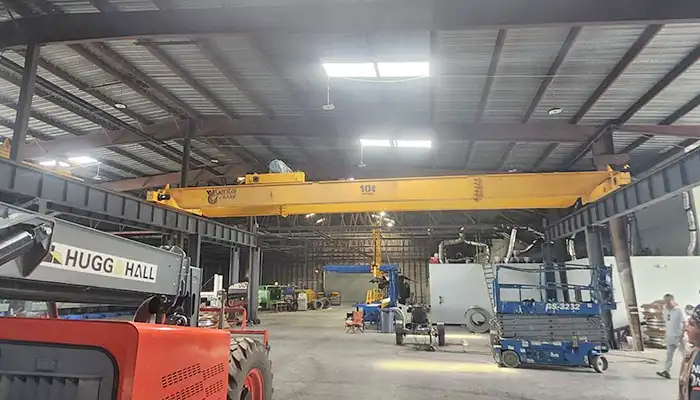
Affordable 10 ton double girder overhead crane with CD/MD hoist trolley, built for U.S. standards, ideal for construction and industrial lifting
Free consultation to Confirm Parameters & Specifications and Get
Latest Crane Price & Crane Rate.
- Types of overhead cranes : _______?
- Optional: Overhead travelling crane, goliath gantry crane,Slewing jib crane, Single girder or double girder crane,small portable crane or kbk crane, etc.
- Capacity of overhead crane: _______?
- Optional: 0.25ton, 0.5 ton, 1 ton, 2 ton, 3ton, 5 ton, 10 ton,15ton, 20ton, 25 ton, 30ton,35ton, up to 550ton, etc.
- Crane span & lifting height : _______?
- Crane travelling length : _____?
- Control of overhead crane:_______?
- Optional: pendant/ remote/cabin control
- Voltage supply of overhead crane:_____?
- Eg,: 380V50/60HZ,3Phase or others,etc.
- Application/usage of crane:_______?
- Eg,: Steel mill, ,injection mold, cement,stone, concrete,granite, general manufacturing, etc.
Just leave a message via the contact form and our hoist and crane engineer will contact you with in 24working hours.
Get In Touch
